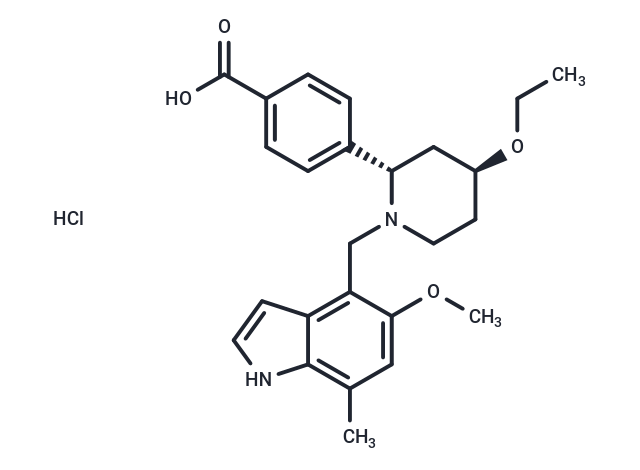Shopping Cart
- Remove All
 Your shopping cart is currently empty
Your shopping cart is currently empty

Iptacopan hydrochloride (LNP023 hydrochloride) is an orally bioavailable, highly potent and highly selective factor B inhibitor with an IC50 of 10 nM. Iptacopan hydrochloride shows direct, reversible, and high-affinity binding to human factor B with a KD of 7.9 nM.

| Pack Size | Price | Availability | Quantity |
|---|---|---|---|
| 1 mg | $155 | In Stock | |
| 5 mg | $328 | In Stock | |
| 10 mg | $563 | In Stock | |
| 25 mg | $879 | In Stock | |
| 50 mg | $1,190 | In Stock | |
| 100 mg | $1,620 | In Stock | |
| 1 mL x 10 mM (in DMSO) | $333 | In Stock |
| Description | Iptacopan hydrochloride (LNP023 hydrochloride) is an orally bioavailable, highly potent and highly selective factor B inhibitor with an IC50 of 10 nM. Iptacopan hydrochloride shows direct, reversible, and high-affinity binding to human factor B with a KD of 7.9 nM. |
| Targets&IC50 | FB:10 nM, FB:7.9 nM(KD) |
| In vitro | LNP023 demonstrates excellent selectivity over other proteases affording IC50 values of >30 μM across a panel of 41 human proteases, including the AP protein factor D (>100 μM)[3]. |
| In vivo | LNP023 (20-180 mg/kg; oral administration) demonstrates efficacy in both prophylactic and therapeutic dosing in a rat model of membranous nephropathy and prevents KRN (150 μL)-induced arthritis in mice[2]. Following oral administration (rat 30 mg/kg, dog 10 mg/kg), LNP023 exhibits moderate half-lives (T1/2; Wistar Han rats 3.4 h, beagle dogs 5.5 h) and Cmax (Wistar Han rats 410 nM, beagle dogs 2200 nM)[3]. |
| Alias | LNP023 hydrochloride, Iptacopan HCl |
| Molecular Weight | 458.98 |
| Formula | C25H31ClN2O4 |
| Cas No. | 1646321-63-2 |
| Smiles | Cl.CCO[C@H]1CCN(Cc2c(OC)cc(C)c3[nH]ccc23)[C@@H](C1)c1ccc(cc1)C(O)=O |
| Relative Density. | no data available |
| Storage | store at low temperature | Powder: -20°C for 3 years | In solvent: -80°C for 1 year | Shipping with blue ice. | |||||||||||||||||||||||||||||||||||
| Solubility Information | H2O: 50 mg/mL (108.94 mM), Sonication and heating are recommended. DMSO: 50 mg/mL (108.94 mM), Sonication is recommended. | |||||||||||||||||||||||||||||||||||
Solution Preparation Table | ||||||||||||||||||||||||||||||||||||
H2O/DMSO
| ||||||||||||||||||||||||||||||||||||

Copyright © 2015-2025 TargetMol Chemicals Inc. All Rights Reserved.